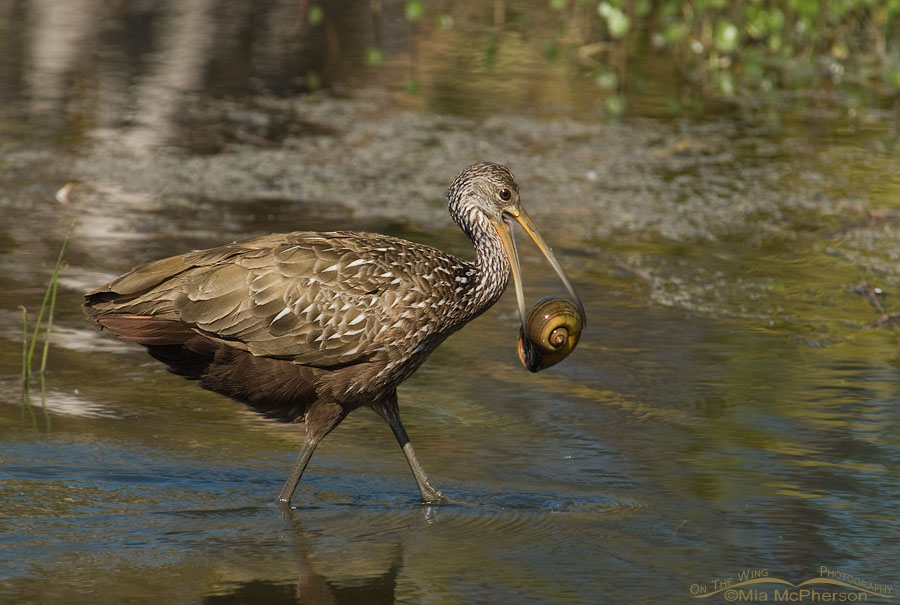 Limpkin portrait in early morning light – Nikon D200, f6.3, 1/250, ISO 320, Nikkor 80-400mm VR at 400mm, early morning light
Limpkin portrait in early morning light – Nikon D200, f6.3, 1/250, ISO 320, Nikkor 80-400mm VR at 400mm, early morning light
Limpkins are related to cranes and rails although their appearance is more like herons and egrets. They are found in southeastern North America in freshwater habitats that can support apple snails, the main diet of Limpkins. Their range is being reduced by development and water level manipulation which directly impacts apple snails and by introduced species. Recent attempts at wetlands restoration in the Everglades and the Upper St Johns River Marsh may offer hope for this curious chocolate colored bird with long legs and a curved bill.
They often hide in among the vegetation of marshes and wooded swamps but can also be found in freshwater canals and ditches. Quite often I would know that Limpkins were present even before I saw them because of their distinctive calls, it is a sound you do not forget once you have heard the eerie quality of their call. There is a sound clip here.
 Limpkin with a snail in its bill – Nikon D200, f6.3, 1/350, ISO 200, Nikkor 80-400mm VR at 400mm, natural light
Limpkin with a snail in its bill – Nikon D200, f6.3, 1/350, ISO 200, Nikkor 80-400mm VR at 400mm, natural light
The photo above shows a Limpkin I saw and photographed as it caught and ate this huge apple snail. This bird took the snail to the shoreline and used its curved bill to remove the snail from its shell. Limpkins also feed on mussels, insects, spiders and other snail species besides the apple snails.
Their nests consist of vegetation placed on the ground or in trees and they produce 1-3 broods a season.
They may not be as beautifully colored as a Roseate Spoonbill or as common as Sandhill Cranes in Florida but to me they are interesting and appealing birds.
Life is good.
Mia
Click here to see more of my Limpkin photos plus facts and information about this species.


tHANK YOU FOR ANSWERING MY QUESTION. bUT THEY ARE EATING SOMETHING BECAUSE THEY ARE STILL AROUND.aPPLE SNAILS DO NOT COME BACK ONCE THRY ARE ALL EATEN?
i DON’T SEE THE SMALL SNAILS, ONLY THE OLD BIG APPLE SNAILS BLEACHING IN THE SUN OVER THE PAST 3 YEARS.i SEE SMALL MOLLUSK HOPE i HAVBE THAT RIGHT, SMALL TINY BLACK SHELLS. IS THAT ENOUGH TO SUSTAIN THE LIMPKINS? i’VE ONLY SEEN ONE LIMPKIN FAMILY AROUND 3 YEARS AGO, WHEN THE APPLE SNAIL WAS ABUNDANT. dON’T WANT TO LOSE THEM.hAVE NOT SEEN ANY SMALL OR TEENY APPLE SNAILS, IN A COUPLE OF YEARS. dO THEY REPRODUCE, IF THEY DO HOW LONG DOES IT TAKE THEM TO GROW INTO SMALL BASEBALL SIZE?
Ann, I don’t think Limpkins eat much of anything but snails because their bills are specifically shaped to eat them. If the snails really are completely disappearing it is likely that the Limpkins will move on. That would be sad.
wHAT HAPPENS WHEN THEY EAT ALL THE APPLE SNAILS IN YOUR LAKES?
It isn’t likely that they would eat all of the snails in the lakes although they may eat the largest ones there are always smaller Apple Snails growing up. If the snails are very noticeably absent I’d be more worried that someone might be poisoning them.
Awesome pics! The snail pic is too cool… I can’t get enough of those portrait shots though, that one is just beautiful!
I agree, the snail in the bill is such a bonus. Great shot!